 W
WThe Art of Painting, also known as The Allegory of Painting, or Painter in his Studio, is a 17th-century oil on canvas painting by Dutch painter Johannes Vermeer. It is owned by the Austrian Republic and is on display in the Kunsthistorisches Museum in Vienna.
 W
WThe Artist in his Studio is an oil painting on panel by Rembrandt c. 1628. The painting shows an artist' studio in realist style. It is held by the Museum of Fine Arts in Boston, Massachusetts.
 W
WL'Atelier Rouge, also known as The Red Studio, is a painting by Henri Matisse from 1911, in the collection of The Museum of Modern Art, New York City.
 W
WBertha Wegmann Painting a Portrait is a 19th-century painting by Jeanna Bauck, showing Bertha Wegmann at work in their joint studio in Munich. It was acquired by the National Museum in Stockholm in 1930 from Ms. Toni Agnes Möller-Wegmann as a gift. The two artists also lived in the studio depicted in the painting. Painted using oil on canvas, the painting measures 100 by 110 centimetres.
 W
WBig Painting No. 6 is a 1965 oil and Magna on canvas painting by Roy Lichtenstein. Measuring 235 cm × 330 cm, it is part of the Brushstrokes series of artworks that includes several paintings and sculptures whose subject is the actions made with a house-painter's brush. It set a record auction price for a painting by a living American artist when it sold for $75,000 in 1970. The painting is in the Kunstsammlung Nordrhein-Westfalen collection.
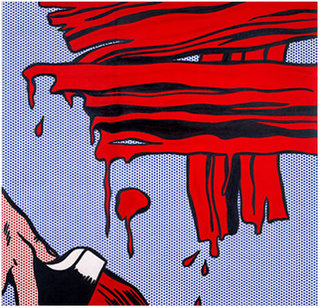 W
WBrushstrokes is a 1965 oil and Magna on canvas pop art painting by Roy Lichtenstein. It is the first element of the Brushstrokes series of artworks that includes several paintings and sculptures. As with all of his Brushstrokes works, it is in part a satirical response to the gestural painting of Abstract Expressionism.
 W
WBrushstrokes series is the name for a series of paintings produced in 1965–66 by Roy Lichtenstein. It also refers to derivative sculptural representations of these paintings that were first made in the 1980s. In the series, the theme is art as a subject, but rather than reproduce masterpieces as he had starting in 1962, Lichtenstein depicted the gestural expressions of the painting brushstroke itself. The works in this series are linked to those produced by artists who use the gestural painting style of abstract expressionism made famous by Jackson Pollock, but differ from them due to their mechanically produced appearance. The series is considered a satire or parody of gestural painting by both Lichtenstein and his critics. After 1966, Lichtenstein incorporated this series into later motifs and themes of his work.
 W
WCaspar David Friedrich in his Studio refers to two paintings by the German romantic artist Georg Friedrich Kersting of 1811 and 1819. Of these the 1819 version is the best known. In these two paintings Kersting depicted fellow German painter Caspar David Friedrich in his studio.
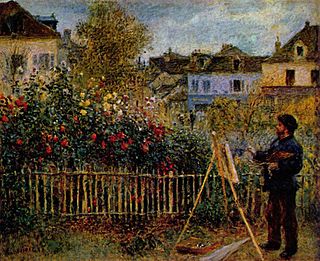 W
WClaude Monet Painting in His Garden at Argenteuil is an 1873 Impressionist painting by Pierre-Auguste Renoir.
 W
WClaude Monet Painting in his Studio or Monet in his Boat is an 1874 oil on canvas painting by Édouard Manet. It shows his friend Claude Monet painting in his 'studio-boat' with his wife. This was an old boat Monet had bought around 1871 or 1872, from which he observed the light on the Seine – Daubigny also had a studio-boat called the Bottin. With The Monet Family in their Garden and Argenteuil, it was one of a number of paintings produced during a summer Manet spent with Monet. The work is now in the Neue Pinakothek.
 W
WThe Ecumenical Council is a surrealist painting by Spanish artist Salvador Dalí completed in 1960. It is one of his masterpieces, taking two years to complete and very large at 299.7 by 254 centimetres. The painting is a complex assemblage of art historical references and religious scenes emphasizing Catholic symbolism.
 W
WFrédéric Bazille at his Easel is an 1867 oil on canvas painting by Auguste Renoir, produced in response to Frédéric Bazille's own 1867 portrait of Renoir. It is owned by the Musée d'Orsay, which has deposited it at the Musée Fabre in Montpellier, Bazille's birthplace.
 W
WHogarth Painting the Comic Muse is a painting in the National Portrait Gallery, London by the British artist William Hogarth. It was painted in approximately 1757 and published as a print in etching and engraving in 1758, with its final and sixth state in 1764. Hogarth used this particular self-portrait as the frontispiece of his collected engravings, published in 1764.
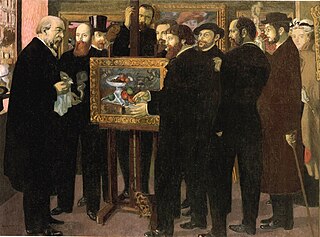 W
WHomage to Cézanne is a painting in oil on canvas by the French artist Maurice Denis dating from 1900. It depicts a number of key figures from the once secret brotherhood of Les Nabis. The painting is a retrospective; by 1900 the group was breaking up as its members matured.
 W
WThe Human Condition generally refers to two similar oil on canvas paintings by the Belgian surrealist René Magritte. One was completed in 1933 and is in the collection of the National Gallery of Art in Washington DC. The other was completed in 1935 and is part of the Simon Spierer Collection in Geneva, Switzerland. A number of drawings of the same name exist as well, including one at the Cleveland Museum of Art.
 W
WLittle Big Painting is a 1965 oil and Magna on canvas pop art painting by Roy Lichtenstein. It is part of the Brushstrokes series of artworks that include several paintings and sculptures. It is located at the Whitney Museum of American Art in New York City. As with all of his Brushstrokes works, it is in part a satirical response to the gestural painting of abstract expressionism.
 W
WMasterpiece is a 1962 pop art painting by Roy Lichtenstein that uses his classic Ben-Day dots and narrative content contained within a speech balloon. In 2017 the painting sold for $165 million.
 W
WLas Meninas is a 1656 painting in the Museo del Prado in Madrid, by Diego Velázquez, the leading artist of the Spanish Golden Age. Its complex and enigmatic composition raises questions about reality and illusion, and creates an uncertain relationship between the viewer and the figures depicted. Because of these complexities, Las Meninas has been one of the most widely analyzed works in Western painting.
 W
WThe Painter and His Model is a work by Henri Matisse painted late 1916, early 1917. It is currently in the collection of the Musée National d'Art Moderne, Centre Georges Pompidou, Paris. In this work Matisse depicted himself in his studio on the fourth floor of 19 Quai Saint-Michel, at work on his painting Laurette in a Green Robe (1916).
 W
WThe Painter of Sunflowers is a portrait of Vincent van Gogh by Paul Gauguin in December 1888.
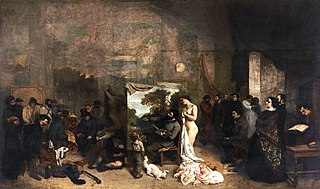 W
WThe Painter's Studio: A real allegory summing up seven years of my artistic and moral life is an 1855 oil on canvas painting by Gustave Courbet. It is located in the Musée d'Orsay in Paris, France.
 W
WRaphael and La Fornarina was painted in 1813, in Italy, by Jean-Auguste-Dominique Ingres. It is the first of five versions of the painting, which he completed between 1813 and his death in 1867. In 1814 his first version was exhibited at the Salon. The work shows the renowned painter, Raphael, sitting in his studio with his mistress, La Fornarina, on his knee. His embrace reflects his affection and desire for her, while his gaze towards his own artwork, his portrait of his mistress, indicates his love for art. This contrast represents the painter's major conflict between who he loves and what he loves. The mistress makes eye contact with the viewer and her posture, specifically her arms resting on his shoulders, shows how proud and satisfied she is with being his mistress and inspiration. The Fornarina's sensual gaze at the viewer claims her importance and place both within the artist's studio and profession. Although Ingres thoroughly researched the Renaissance artist's life through biographies by Giorgio Vasari and Angelo Comolli, and planned to create a series of paintings based on his life, in the end he only produced two scenes: Raphael and La Fornarina, and its succeeding versions, and the Betrothal of Raphael. The depiction of the Fornarina resembles not only the Virgin Mary, in the painting in the background of the Madonna della seggiola, but also Ingres' depiction of the promiscuous Grande Odalisque. The illustration highlights an interconnection between Raphael and Ingres as they both paint what they desire.
 W
WRosa Bonheur is an 1898 painting by Anna Elizabeth Klumpke. The portrait of the French artist Rosa Bonheur has been in the collection of the Metropolitan Museum of Art since 1922.
 W
WSaint Luke Painting the Crucifixion is a c.1650 oil on canvas painting by Francisco de Zurbarán, also known as Crucifixion with Saint Luke or The Crucified Christ with a Painter. It is now in the Prado Museum. The figure of Saint Luke is thought to be a self-portrait of the artist.
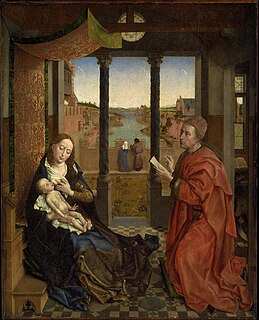 W
WSaint Luke painting the Virgin,, is a devotional subject in art showing Luke the Evangelist painting the Virgin Mary with the Child Jesus. Such paintings were often created during the Renaissance for chapels of Saint Luke in European churches, and frequently recall the composition of the Salus Populi Romani, an icon based on the legend of Luke's portrait of Mary. Versions of the subject were sometimes painted as the masterpiece that many guilds required an artist to submit before receiving the title of master.
 W
WSaint Luke painting the Virgin is a 1532 painting by the Dutch Golden Age artist Maarten van Heemskerck in the Frans Hals Museum.
 W
WSaint Luke Painting the Virgin is a 1650-1655 painting by Luca Giordano, now in the Musée des Beaux-Arts de Lyon. It shows Saint Luke painting the Virgin. Another work on the same subject by the same artist is now in the Museo de Arte in Ponce, Puerto Rico.
 W
WThe Savior of Painting is a 1997 painting by the Norwegian artist Odd Nerdrum. It is also known as Self-Portrait as the Prophet of Painting. It depicts Nerdrum in a golden robe, standing barefoot under the evening sky, with a paintbrush in his right hand and a palette in his left.
 W
WThe Self Portrait of Italian baroque artist Artemisia Gentileschi was painted in the early 1630s. It currently hangs in the Palazzo Barberini, Rome. It is one of many paintings where Gentileschi depicts herself. Beyond self-portraits, her allegorical and religious paintings often featured herself in different guises.
 W
WSelf-Portrait is an oil on canvas painting by Flemish painter Paul Bril. It was probably painted between 1595 and 1600, and is currently housed at the Rhode Island School of Design Museum in Providence, Rhode Island.
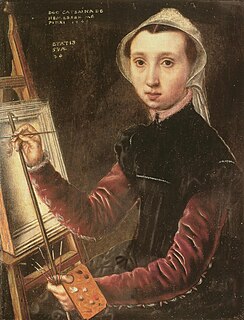 W
WSelf-Portrait is a small painting executed in oil on oak in 1548 by the Flemish Renaissance artist Caterina van Hemessen when she was 20 years old. The painting earned her a considerable reputation during her lifetime and is significant not only for being an early modern female portrait but also for representing an artist in the act of painting. This was very unusual for the time; although self-portraits were common, only a few, like those of Albrecht Dürer (1471–1528), showed the artist's social position and everyday life. Artists of the time rarely directly referred to, much less showed the tools of their profession. Hemessen's portrait is one of the earliest in the Northern European tradition to show a painter not only with a brush but also a palette and easel. She inscribed it with the words: "I Caterina van Hemessen have painted myself / 1548 / Her aged 20".
 W
WSelf-Portrait as the Allegory of Painting, also known as Autoritratto in veste di Pittura or simply La Pittura, was painted by the Italian Baroque artist Artemisia Gentileschi. The oil-on-canvas painting measures 96.5 by 73.7 centimetres and was probably produced during Gentileschi's stay in England between 1638 and 1639. It was in the collection of Charles I and was returned to the Royal Collection at the Restoration (1660) and remains there. In 2015 it was put on display in the "Cumberland Gallery" in Hampton Court Palace.
 W
WSelf-portrait by Judith Leyster is an Dutch Golden Age painting in oils in the collection of the National Gallery of Art that was offered in 1633 as a masterpiece to the Haarlem Guild of St. Luke. It was attributed for centuries to Frans Hals and was only properly attributed to Judith Leyster upon acquisition by the museum in 1949. The style is indeed comparable to that of Hals, Haarlem's most famous portraitist.
 W
WSelf-Portrait with Death Playing the Fiddle is a painted self-portrait executed in 1872 by the Swiss symbolist artist Arnold Böcklin. He first exhibited at the Kunstverein München in the same year, establishing his reputation in Munich's artistic community. It is now in the Alte Nationalgalerie in Berlin.
 W
WSelf-Portrait with Easel is a painting by the Flemish artist Michaelina Wautier. It shows Wautier beginning her painting, having sketched the outline of the head of a portrait. It was painted some time in the 1640s. Despite having been part of various art collections since being completed, it was only identified as being by Wautier in 2013. For a long time, the painting was attributed to the Italian artist Artemisia Gentileschi. Indeed a 1905 photograph of the painting showed the name Artemisia on the base of the column to the left. It is unknown who added this signature, which is no longer present. A watch with a pink ribbon attached to it sits on the easel, but the precise reason for its inclusion is not known.
 W
WSelf-Portrait with Palette is an 1878–79 oil-on-canvas painting by the French artist Édouard Manet. This late impressionistic work is one of his two self-portraits. Velasquez's self-portrait in Las Meninas was a particular inspiration for Manet's painting which despite its allusion to the previous artist's work is very modern in its focus upon the personality of the artist and loose paint handling.
 W
WSelf-Portrait with Seven Fingers is an oil painting by Belarusian painter Marc Chagall, painted in 1913 in France. This oil on canvas is a self-portrait in which the artist represents himself painting a reduced version of Of Russia, of Donkeys and Others, with seven fingers on one hand. It is kept as part of the Chagall collection at the Stedelijk Museum Amsterdam, in Amsterdam, Netherlands.
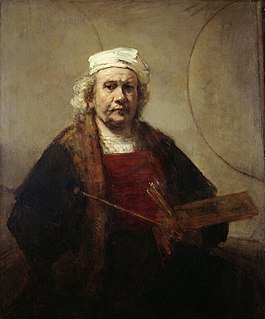 W
WSelf-Portrait with Two Circles is an oil on canvas painting by the Dutch artist Rembrandt, painted c. 1665–1669, one of over 40 painted self-portraits by Rembrandt.
 W
WSelf-Portrait with Two Pupils, Marie Gabrielle Capet and Marie Marguerite Carreaux de Rosemond is a 1785 self-portrait painting by Adélaïde Labille-Guiard depicting the artist with two of her pupils, Marie Gabrielle Capet and Marie-Marguerite Carreaux de Rosemond. It is in the collection of the Metropolitan Museum of Art.
 W
WA Session of the Painting Jury is an oil on canvas painting by the French artist Henri Gervex, probably undertaken in 1885. The painting, a piece of official art during the Third Republic, shows a meeting of the painting jury of the Salon, the official exhibition of the Académie des Beaux-Arts, in 1883.
 W
WA Studio at Les Batignolles is a painting by Henri Fantin-Latour created in 1870. The work is now at the Musée d'Orsay.
 W
WStudio in Rue de La Condamine or Bazille's Studio is an 1870 painting by the French artist Frédéric Bazille. An early Impressionist work, it has been in the Musée d'Orsay in Paris since 1986.
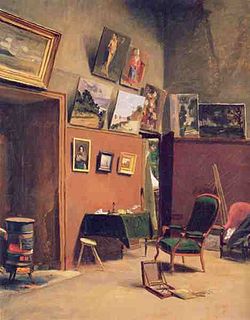 W
WStudio on Rue Furstenberg is an 1866 painting by Frédéric Bazille of the studio he was sharing with Claude Monet at 6 Place de Furstenburg in the 6th arrondissement of Paris in January 1866. Monet had painted his Le Déjeuner sur l'herbe in the same studio in 1865. One floor down in the same building was the studio used by Eugène Delacroix between 1857 and his death to be close to the église Saint-Sulpice, where he was painting a chapel – that studio was later used by Diogène Maillart, Delacroix's student, whilst working to win the first prize for painting in 1864. The whole building is now the Musée national Eugène-Delacroix.
 W
WStudio with Gloves is a 1993 oil on canvas painting by the Welsh artist Shani Rhys James in the National Library of Wales.
 W
WYellow and Green Brushstrokes is a 1966 oil and Magna on canvas pop art painting by Roy Lichtenstein. It is part of the Brushstrokes series of artworks that includes several paintings and sculptures. It is located at the Museum für Moderne Kunst in Frankfurt, Germany. As with all of his Brushstrokes works, it is in part a satirical response to the gestural painting of Abstract Expressionism. It is in the collection of the Museum für Moderne Kunst..
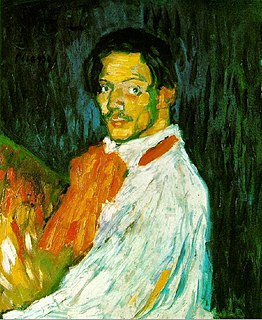 W
WYo, Picasso, is an oil on canvas painting by Pablo Picasso done in 1901.
 W
WA young artist considers a sketch in a mirror is a painting by Wilhelm Bendz from 1826; it is one of the series of Danish Golden Age portraits of artists.